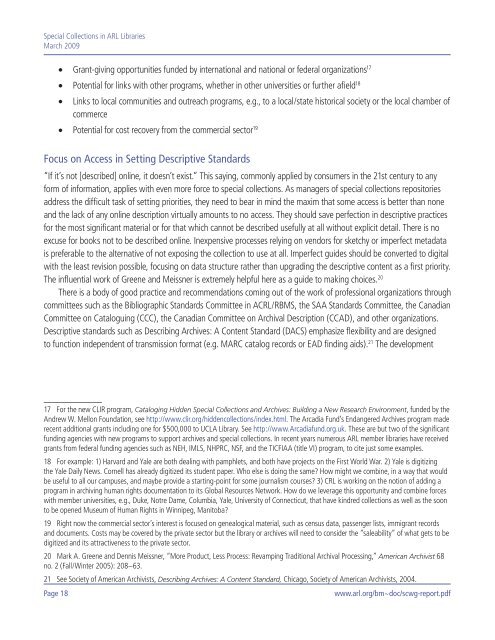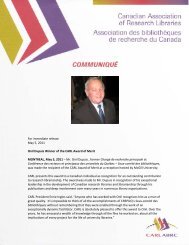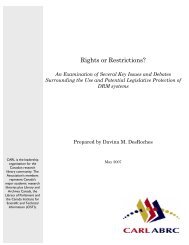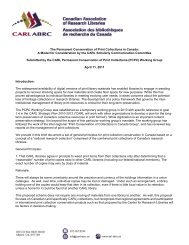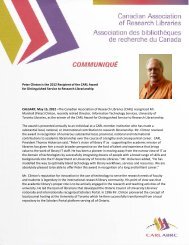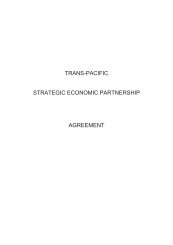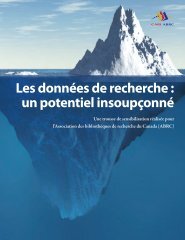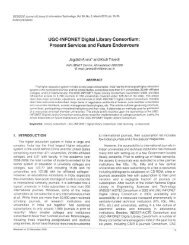PDF - CARL - ABRC
PDF - CARL - ABRC
PDF - CARL - ABRC
You also want an ePaper? Increase the reach of your titles
YUMPU automatically turns print PDFs into web optimized ePapers that Google loves.
Special Collections in ARL Libraries<br />
March 2009<br />
• Grant-giving opportunities funded by international and national or federal organizations 17<br />
• Potential for links with other programs, whether in other universities or further afield18 • Links to local communities and outreach programs, e.g., to a local/state historical society or the local chamber of<br />
commerce<br />
• Potential for cost recovery from the commercial sector19 Focus on Access in Setting Descriptive Standards<br />
“If it’s not [described] online, it doesn’t exist.” This saying, commonly applied by consumers in the 21st century to any<br />
form of information, applies with even more force to special collections. As managers of special collections repositories<br />
address the difficult task of setting priorities, they need to bear in mind the maxim that some access is better than none<br />
and the lack of any online description virtually amounts to no access. They should save perfection in descriptive practices<br />
for the most significant material or for that which cannot be described usefully at all without explicit detail. There is no<br />
excuse for books not to be described online. Inexpensive processes relying on vendors for sketchy or imperfect metadata<br />
is preferable to the alternative of not exposing the collection to use at all. Imperfect guides should be converted to digital<br />
with the least revision possible, focusing on data structure rather than upgrading the descriptive content as a first priority.<br />
The influential work of Greene and Meissner is extremely helpful here as a guide to making choices. 20<br />
There is a body of good practice and recommendations coming out of the work of professional organizations through<br />
committees such as the Bibliographic Standards Committee in ACRL/RBMS, the SAA Standards Committee, the Canadian<br />
Committee on Cataloguing (CCC), the Canadian Committee on Archival Description (CCAD), and other organizations.<br />
Descriptive standards such as Describing Archives: A Content Standard (DACS) emphasize flexibility and are designed<br />
to function independent of transmission format (e.g. MARC catalog records or EAD finding aids). 21 The development<br />
17 For the new CLIR program, Cataloging Hidden Special Collections and Archives: Building a New Research Environment, funded by the<br />
Andrew W. Mellon Foundation, see http://www.clir.org/hiddencollections/index.html. The Arcadia Fund’s Endangered Archives program made<br />
recent additional grants including one for $500,000 to UCLA Library. See http://www.Arcadiafund.org.uk. These are but two of the significant<br />
funding agencies with new programs to support archives and special collections. In recent years numerous ARL member libraries have received<br />
grants from federal funding agencies such as NEH, IMLS, NHPRC, NSF, and the TICFIAA (title VI) program, to cite just some examples.<br />
18 For example: 1) Harvard and Yale are both dealing with pamphlets, and both have projects on the First World War. 2) Yale is digitizing<br />
the Yale Daily News. Cornell has already digitized its student paper. Who else is doing the same? How might we combine, in a way that would<br />
be useful to all our campuses, and maybe provide a starting-point for some journalism courses? 3) CRL is working on the notion of adding a<br />
program in archiving human rights documentation to its Global Resources Network. How do we leverage this opportunity and combine forces<br />
with member universities, e.g., Duke, Notre Dame, Columbia, Yale, University of Connecticut, that have kindred collections as well as the soon<br />
to be opened Museum of Human Rights in Winnipeg, Manitoba?<br />
19 Right now the commercial sector’s interest is focused on genealogical material, such as census data, passenger lists, immigrant records<br />
and documents. Costs may be covered by the private sector but the library or archives will need to consider the “saleability” of what gets to be<br />
digitized and its attractiveness to the private sector.<br />
20 Mark A. Greene and Dennis Meissner, “More Product, Less Process: Revamping Traditional Archival Processing,” American Archivist 68<br />
no. 2 (Fall/Winter 2005): 208–63.<br />
21 See Society of American Archivists, Describing Archives: A Content Standard, Chicago, Society of American Archivists, 2004.<br />
Page 18 www.arl.org/bm~doc/scwg-report.pdf


